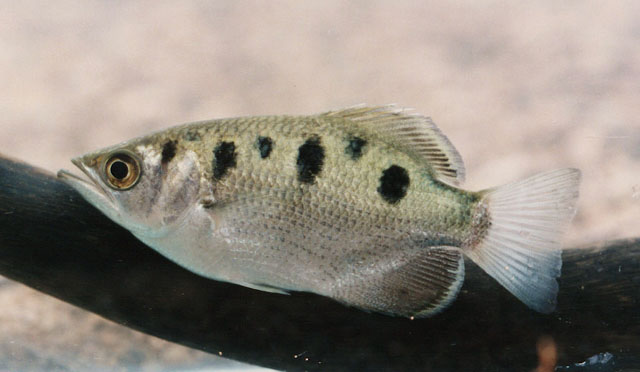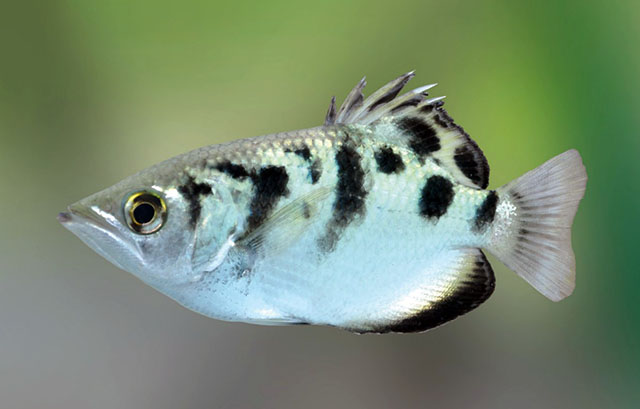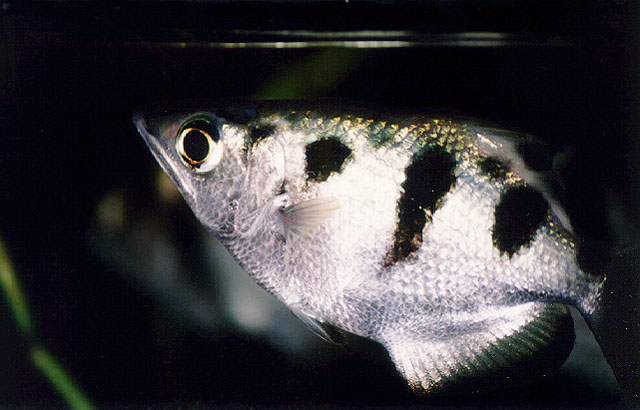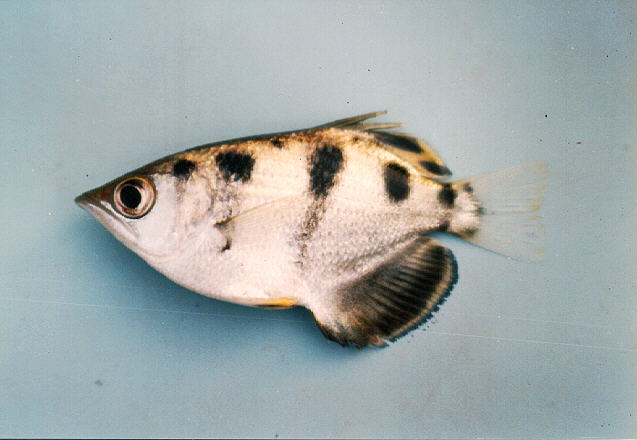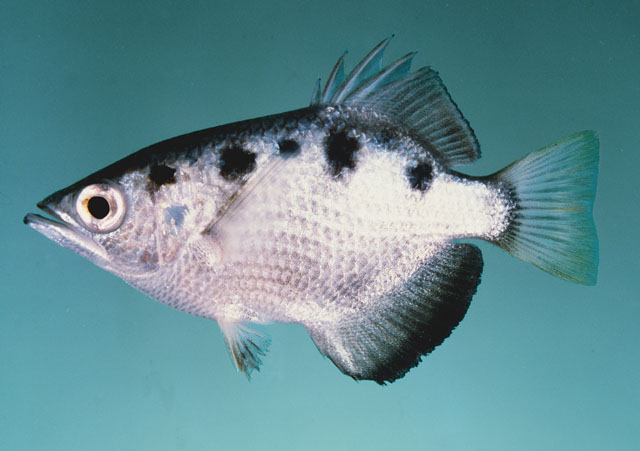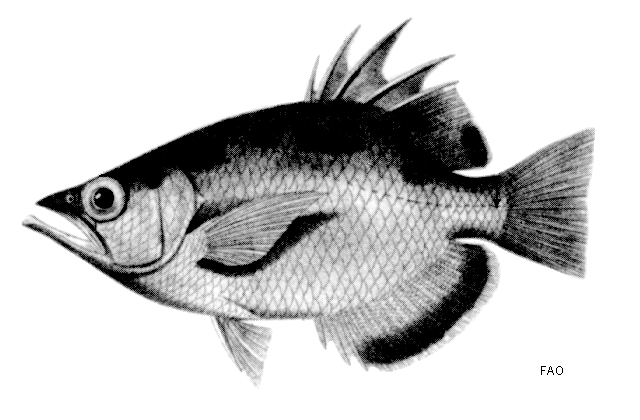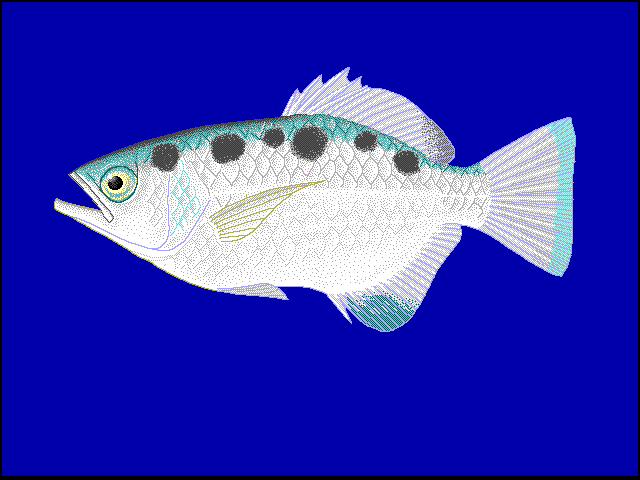Toxotes
chatareus
(Hamilton,
1822)
Spotted archerfish
View all media / Upload your photos and videos
Expand all
Classification / Names
Teleostei (teleosts) > Carangaria/misc (Various families in series Carangaria) >
Toxotidae (Archerfishes)
More on author:
Hamilton.
Environment / milieu / depth range / climate zone / distribution range
Distribution
Asia and Oceania: Sri Lanka and India to New Guinea and northern Australia.
Length at first maturity / Size / Weight / Age
Short description
Biology
Occurs mainly in brackish mangrove estuaries, but also penetrates freshwater rivers and small streams (Ref. 4833, 44894). Inhabits coastal waters (Ref. 45255). Found along the shores of flowing and standing waters. Occurs in shaded areas with overhanging vegetation (Ref. 12693, 44894). Inhabits medium to large-sized rivers (Ref. 12975). Also found in lakes and billabongs (Ref. 44894). Feeds at the surface during the day on floating debris which includes insects and vegetable matter (Ref. 2847). Also consumes crustaceans and small fishes (Ref. 44894). Renowned for its habit of spitting to dislodge its insect prey from tree branches above the water; maximum shooting range is about 150 cm. Breeds from both fresh and brackish water (Ref. 2847, 44894). Breeding takes place in the wet season. Highly fecund female releases buoyant eggs (Ref. 44894). Lays 20,000 to 150,000 eggs, measuring about 0.4 mm in diameter (Ref. 6028). Occasionally caught by anglers and is reasonable eating (Ref. 44894). Sold fresh in markets.
Main reference
Allen, G.R. 1991 Field guide to the freshwater fishes of New Guinea. Publication, no. 9. 268 p. Christensen Research Institute, Madang, Papua New Guinea. (Ref. 2847)
IUCN Red List Status (Ref. 125652)
Least Concern (LC); date assessed: February 15 2019
CITES (Ref. 123416)
Not Evaluated
CMS (Ref. 116361)
Not Evaluated
Threat to humans
Harmless
More information
- Countries
- FAO areas
- Ecosystems
- Occurrences
- Introductions
- Stocks
- Ecology
- Diet
- Food items
- Food consumption
- Ration
- Common names
- Synonyms
- Metabolism
- Predators
- Ecotoxicology
- Reproduction
- Maturity
- Spawning
- Spawning aggregation
- Fecundity
- Eggs
- Egg development
- Age/Size
- Growth
- Length-weight
- Length-length
- Length-frequencies
- Morphometrics
- Morphology
- Larvae
- Larval dynamics
- Recruitment
- Abundance
- References
- Aquaculture
- Aquaculture profile
- Strains
- Genetics
- Allele frequencies
- Heritability
- Diseases
- Processing
- Mass conversion
- Vision
- Pictures
- Stamps, Coins Misc.
- Sounds
- Ciguatera
- Speed
- Swim. type
- Gill area
- Otoliths
- Brains
Estimates based on models
Phylogenetic diversity index (Ref. 82804): PD50 = 0.5156 [Uniqueness, from 0.5 = low to 2.0 = high].
Bayesian length-weight: a=0.01660 (0.00635 - 0.04340), b=3.00 (2.78 - 3.22), in cm total length, based on LWR estimates for this (Sub)family-body shape (Ref. 93245).
Trophic level (Ref. 69278): 4.0 ±0.5 se; Based on diet studies.
Generation time: 3.5 ( na - na) years. Estimated as median ln(3)/K based on 1 growth studies.
Resilience (Ref. 120179): Medium, minimum population doubling time 1.4 - 4.4 years (tm=1-2; k=0.31).
Fishing vulnerability (Ref. 59153): Moderate vulnerability (35 of 100).
Price category (Ref. 80766): Unknown.
Nutrients (Ref. 124155): Calcium = 112 [57, 241] mg/100g; Iron = 1.24 [0.73, 2.24] mg/100g; Protein = 18.5 [17.4, 19.6] %; Omega3 = 0.241 [0.132, 0.425] g/100g; Selenium = 48.1 [21.6, 100.6] μg/100g; VitaminA = 24.3 [7.1, 81.4] μg/100g; Zinc = 1.04 [0.69, 1.56] mg/100g (wet weight);

